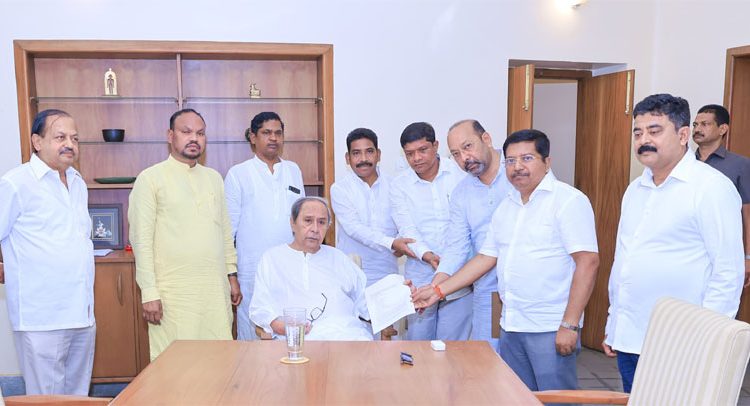Bhubaneswar: At the behest of BJD state President Sri Naveen Patnaik the fact finding team made an extensive visit on the affected areas Malkangiri on 8th August to asses the impact of Polavarum project
After Visiting the affected areas of Malkangiri, BJD Fact-Finding Team consisting of members Sri Atanu Sabyasachi Nayak, Sri Bhrugu Baxipatra, Sri Ramesh Majhi, Sri Manohar Randhari, MLA, Sri Jhinna Hikaka, Sri Raghuram Padal, Sri Manas Madkami, Sri Rabi Narayan Nanda, Sri Iswar Chandra Panigrahi,submitted its report to party president Monday evening.
The Areas the team Visited are Motu and Podia blocks of Malkangiri district. The Biju Janata Dal (BJD) Fact-Finding Team embarked on a crucial visit to the Malkangiri district of Odisha on 8th August 2024 to assess the impact of the proposed Polavaram Project on the local communities and environment and found the followings.
Site Visits and Observations
- Kaleru Village, Andhra Pradesh
The team commenced its visit at Kaleru village in Andhra Pradesh, where they interacted with local residents. The residents expressed their extreme anger and frustration over the proposed Polavaram Project. They highlighted that their villages are already prone to severe flooding during heavy rains, which has become a recurring issue, occurring at least two to three times every year.
The villagers fear that the construction of the Polavaram Dam will exacerbate the flooding situation, leading to further displacement and destruction of their livelihoods. - Mugi Point, Odisha
The team proceeded to Mugi Point, which is the last landmass of Odisha. This location is of great significance as it is the confluence point of the Saberi, Sileru, and Godavari rivers, and also the meeting point of the states of Odisha, Chhattisgarh, and Andhra Pradesh.
At Mugi Point, the team met with officials from the Irrigation Department. The officials provided alarming information about the anticipated height of the Polavaram Dam, which could range between 150 to 180 feet. However, they also informed that no impact assessment has been done yet. Despite repeated requests, the officials from the Polavaram Project have not shared the map or any other relevant documents with them.
The team also observed the construction of a bridge by Chhatisgarh Government over the Sileru River at a considerable height, which further raises concerns about the potential damage that could be caused by the Polavaram Project. - Villages of Motu Block: Alama, Muraliguda, Bariwansa, and Binayakpur
The team then visited the villages of Alama, Muraliguda, Bariwansa, and Binayakpur in the Motu block. These villages are inhabited by tribal communities who have been living in harmony with nature for generations. The residents shared their agony and pain, which they have been enduring since 2006, as their villages are frequently submerged during heavy rains. They stated that their entire vegetation and agricultural land get flooded at least two to three times a year, causing immense damage to their livelihoods.
The tribal residents vehemently opposed the construction of the Polavaram Project, expressing their fears that the project would lead to the complete submergence of their villages. They appealed to the Odisha government and the central government to halt the construction of the Polavaram Project. The residents also urged Sri Naveen Patnaik to present their plight at the appropriate forums to ensure that their voices are heard, and the project is stopped.
However, they also expressed a pragmatic view that if the Andhra Pradesh and central governments proceed with the project, they should be adequately compensated. They demanded compensation at least three times the estimated damage to their property and livelihoods. - Motu Block Headquarters
The final leg of the team’s visit was to the Motu block headquarters. The residents of this area expressed grave concerns that the Polavaram Project would lead to the complete submergence of at least 200 villages and more than 6000 population majority of whom are tribals in the Motu and Podia blocks. The team was informed that the Motu block headquarters itself would be entirely submerged.
One of the most alarming findings was the complete lack of public consultation or hearing in the affected villages by the authorities responsible for the Polavaram Project. There has been no survey conducted to assess the potential damage to human life, livestock, agricultural produce, government institutions, public infrastructure, or the environment.
The fact-finding visit to the Malkangiri district has revealed the immense concerns and grievances of the local communities affected by the proposed Polavaram Project. The residents of the Motu and Podia blocks facing a grave threat to their lives, livelihoods, and cultural heritage due to the potential submergence caused by the project.
The recent budgetary allocation by the Central Government and the Central Government declared commitment to complete the project by February 2026 has raised fear and concern among the tribal inhabitants of about 200 villages of Motu and Podia Blocks.

